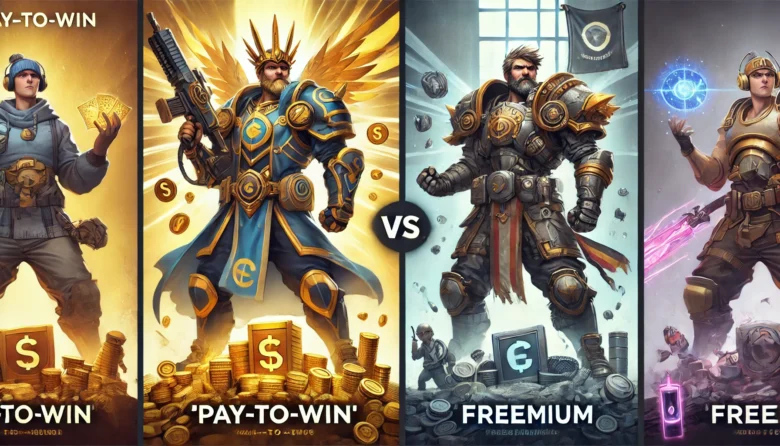In today’s digital age, video games are more than just a source of entertainment—they’ve become powerful economic engines. From blockbuster titles to mobile games, the world of gaming has transformed into a multibillion-dollar industry. But behind the flashy graphics and exciting gameplay lies a “hidden economy” that most players unknowingly fuel. In-game purchases, also known as microtransactions, are the driving force behind this silent financial revolution. Whether it’s buying a special character skin, unlocking new levels, or upgrading gear, in-game purchases have shifted the landscape of global markets in ways we might not have anticipated.
The Rise of In-Game Purchases: A New Business Model
It wasn’t long ago when buying a video game meant owning the complete experience. You’d buy a physical copy, pop it into your console or PC, and enjoy endless hours of gameplay without further cost. However, with the rise of mobile gaming and online platforms, the business model changed. Today, many games are offered for free (often referred to as “freemium”), where players can download and play without spending a dime—until they reach the in-game store.
Take Fortnite, for example. Released by Epic Games (a company known for developing software and games), this free-to-play battle royale became a global sensation. But what truly made headlines was its revenue model. In 2019 alone, Fortnite generated over $1.8 billion, not through game sales but in-game purchases like skins (cosmetic items), emotes (character actions), and battle passes (a subscription-like feature for unlocking exclusive content). This shift highlights how the hidden economy of video games taps into player engagement, encouraging spending beyond the initial purchase.

Microtransactions: The Building Blocks of Revenue
Microtransactions come in various forms, but their underlying principle is simple: players spend small amounts of real money to enhance their gaming experience. These small transactions can include:
Cosmetic Items: Non-essential purchases like skins or costumes for characters.
Loot Boxes: Randomized rewards where players pay for a chance to unlock rare or special items.
Power-ups and Game Progress: Speeding up gameplay by purchasing boosts or unlocking new levels without grinding through the game.
One of the most famous examples of successful microtransactions is League of Legends, developed by Riot Games (a developer specializing in multiplayer online battle arena games). The game, despite being free-to-play, earns millions every year through cosmetic skins. Players don’t need these skins to win, but they buy them to personalize their gaming experience.
Case Study: The Mobile Gaming Boom
The mobile gaming industry deserves special mention when it comes to in-game purchases. With the accessibility of smartphones, mobile games have reached a broader audience than ever before, including people who wouldn’t traditionally consider themselves “gamers.”
Candy Crush Saga, a puzzle game developed by King (a leading interactive entertainment company), pioneered the model of monetizing through microtransactions. While the game itself is free to play, it offers players the option to buy additional lives, boosters, or levels to enhance their experience. In 2020, the game earned more than $1.2 billion from these small purchases, demonstrating the power of the mobile gaming sector.
Another notable example is Clash of Clans by Supercell (a mobile game development company). This strategy game offers in-game purchases that allow players to upgrade buildings, troops, and resources. The clever design of the game encourages users to spend money to progress faster, and in 2019 alone, the game generated over $727 million in revenue.
The Hidden Impact on Global Markets
With billions of dollars flowing through this hidden economy, in-game purchases are influencing markets in significant ways. The video game industry now surpasses both the film and music industries combined, with an estimated global market value of $159 billion in 2020. In-game purchases contribute a substantial chunk to this figure.
Interestingly, the influence goes beyond just gaming companies. Payment processing firms like PayPal (a company that provides online money transfers) and Stripe (a payment processing platform) are also reaping the benefits of these microtransactions. As more people buy in-game content, demand for secure, fast, and reliable payment systems grows. In fact, some payment processors have developed systems specifically for handling gaming-related transactions.
Moreover, in-game economies have led to new job opportunities and even whole industries. Virtual item trading, where players buy, sell, or trade in-game assets, has become a booming market. Platforms like Steam (a digital game distribution service) allow players to trade virtual items for real money, blurring the lines between in-game wealth and actual economic value.
Controversies and Challenges
While in-game purchases fuel global markets, they are not without their challenges. Many players and regulators have raised concerns about the ethics of microtransactions, particularly when it comes to “loot boxes”—a system that many argue resembles gambling. In some countries like Belgium and the Netherlands, loot boxes have been banned, while other governments are considering regulations to protect players, especially younger audiences.
Parents, in particular, have been concerned about children unknowingly making large purchases in games. Stories of children racking up thousands of dollars in bills have sparked debates over how transparent and ethical these purchases should be.
Additionally, there’s the issue of “pay-to-win.” In some games, players who spend more money get an unfair advantage over those who don’t, leading to frustration and dissatisfaction among the gaming community.
What Lies Ahead for In-Game Economies?
Despite the controversies, the hidden economy of video games is showing no signs of slowing down. Game developers are continually exploring new ways to integrate microtransactions that feel less intrusive yet still profitable. Subscriptions, like Fortnite’s Battle Pass, may become more popular as players seek value in exclusive content without feeling forced to spend.
The rise of blockchain technology and non-fungible tokens (NFTs) could also revolutionize the in-game economy. Players may soon have ownership over digital assets that they can trade or sell across different platforms, adding another layer of real-world value to virtual goods.
As video games continue to evolve, so too will the ways they impact global markets. What started as a hobby has now become a significant economic force, and the future is wide open for further growth and innovation.
Conclusion
In-game purchases have fundamentally changed the landscape of the video game industry and global markets. What was once a hidden economy is now at the forefront of digital monetization, driving billions of dollars in revenue and influencing markets far beyond the realm of gaming. As consumers, it’s essential to be aware of the financial systems at play behind the screens and understand the value—and potential pitfalls—of in-game purchases.
As gaming continues to grow, so too will the economic forces behind it, shaping both the industry and the broader global economy. Next time you buy that shiny new skin or speed up your progress, you’re not just enhancing your gameplay—you’re contributing to a global market worth billions.
Author’s Note
As someone fascinated by the intersection of technology and economics, exploring the hidden economy of video games opened my eyes to how deeply ingrained these microtransactions are in shaping industries today. I hope this blog helps you better understand the complex financial systems behind the games we all love.
G.C., Ecosociosphere contributor.
References and Further Reading
- How Fortnite Makes Billions Without Charging a Cent
- The Economics of Mobile Games
- The Top Grossing Mobile Games in Today’s Market | Fizy Games. https://fizygames.com/the-top-grossing-mobile-games-in-todays-market/
- Crowntakers App Review | Common Sense Media. https://www.commonsensemedia.org/app-reviews/crowntakers
- Are educators ready for the Metaverse? | Leader.co.za. https://www.leader.co.za/article.aspx?s=211&a=8690&title=L&D
- Passive Income through Online Gaming: How to Make Money While You Sleep – West Sky News. https://westskynews.com/passive-income-through-online-gaming-how-to-make-money-while-you-sleep/
- No Man’s Sky’s New Free Update Breathes Life into its Planets – GameSkinny. https://www.gameskinny.com/j46lg/no-mans-skys-new-free-update-breathes-life-into-its-planets
- Darold Niaz – niazdarold | Live Positively. https://niazdarold.livepositively.com
- How Blockchain is Revolutionizing the Gaming Industry – Harmony Hustle. https://harmonyhustle.com/2023/04/18/how-blockchain-is-revolutionizing-the-gaming-industry/
- Short Video App Development – Cost & Key Features | Smartbiz Design. https://smartbizdesign.com/blog/short-video-app-development





Comments
Somebody essentially lend a hand to make significantly articles Id state That is the very first time I frequented your website page and up to now I surprised with the research you made to make this actual submit amazing Wonderful task
I was recommended this website by my cousin I am not sure whether this post is written by him as nobody else know such detailed about my trouble You are amazing Thanks
Usually I do not read article on blogs however I would like to say that this writeup very compelled me to take a look at and do it Your writing style has been amazed me Thank you very nice article
Your ability to distill complex concepts into digestible nuggets of wisdom is truly remarkable. I always come away from your blog feeling enlightened and inspired. Keep up the phenomenal work!
Nice Article
kinogo